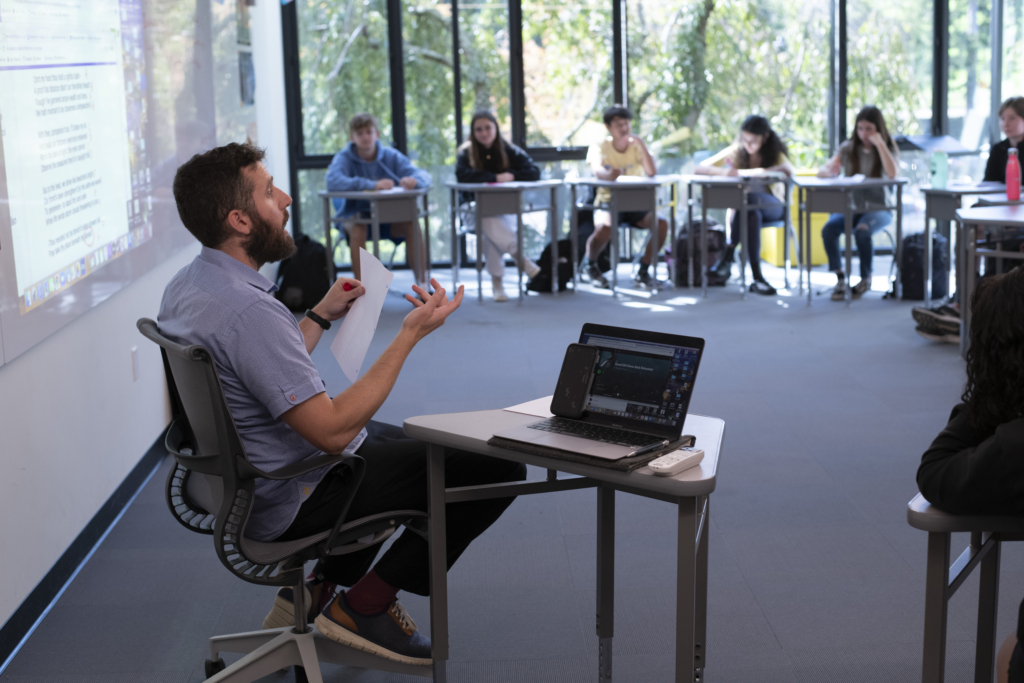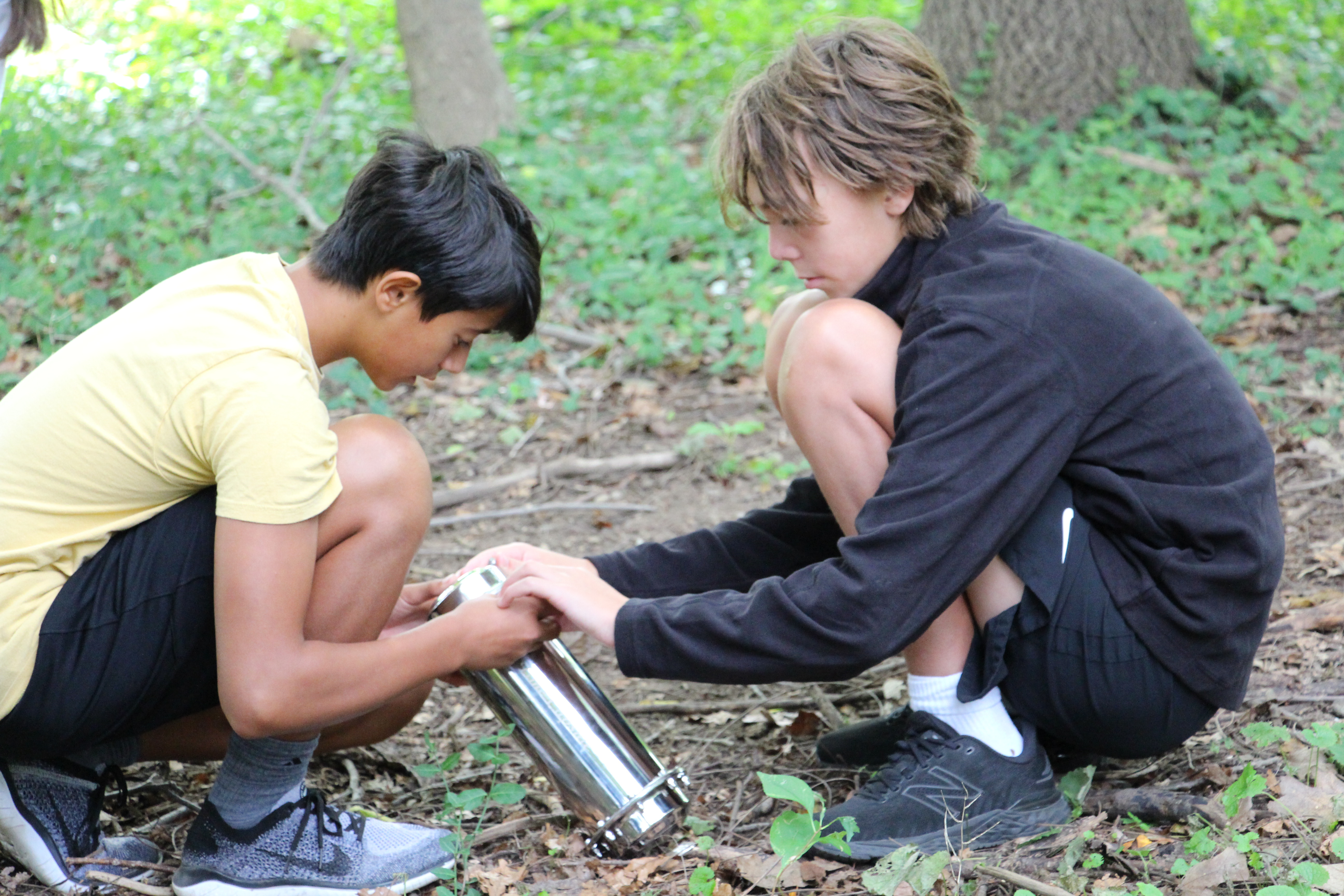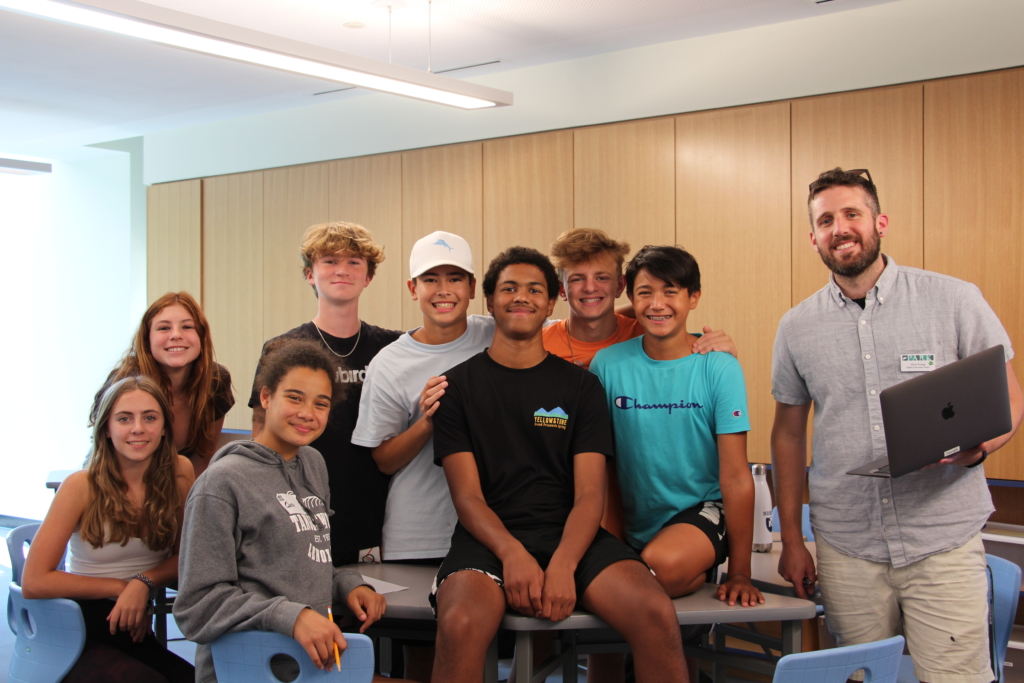One of the gifts of being back on campus “in person” is the opportunities this provides for chance conversations – in the hallways, in the dining hall – about what’s happening in the classroom. In the early weeks of school, once such conversation opened up wonderful insight into not only WHAT was happening in Grade 8 social studies…but WHY.
Grade 8 teacher Nick Young teaches both English and Social Studies, and the threads running between the two disciplines often intertwine, bringing storytelling and writing together within the process of considering our place in society, within history, and in the world. Now in his second year at Park, he opens up the academic year with a Time Capsule project. It’s an engaging, hands-on, fun project that gets students thinking about Park, about their middle school experience, and most importantly, begins challenging them to articulate how they see themselves.
Each member of the class was invited to contribute a letter to their later Grade 8 selves. While this year’s time capsules are made of non-perishable materials, last year’s, constructed of wood and buried on the edge of the Main Field, held up to New England’s elements less well than hoped. “They rotted,” Nick says, and so some of the reflections, when revisited in May, were a tad soggy. Nick observes that this was a compelling lesson in and of itself, noting that “sometimes, history speaks clearly…and sometimes it does not.” The perishable nature of first person experience – not just now, but in ages past – reminds us that we can only know and only interpret so much from the evidence left behind.
Grade 8 is a tremendous year of growth, as young people evolve from eager middle schoolers to students truly ready for high school. Upon re-reading their earlier thoughts, many students said “I can’t believe I wrote that.”

Even so, the exercise of sitting down to reflect on what each Grade 8 student aspires for themselves over the course of this formative year is, in and of itself, significant, and luckily, Nick kept copies of what they wrote. Grade 8 is a tremendous year of growth, as young people evolve from eager middle schoolers to students truly ready for high school. Upon re-reading their earlier thoughts, many students said “I can’t believe I wrote that.”
“I feel very caught up in the 8th grade jump,” Nick says, “and the project is very tied into the work of self-discovery.” The class then moved on into their “Moth” unit, inspired by the Moth Story Hour, which takes this notion of discovery to another level as it challenges students to consider “the things we carry” that shape how we see and interact with the world. Each student began by creating a map that focused on some kind of change at the center of a story. That story could be deeply personal – the change brought on by a diagnosis of cancer in the family – or seemingly trivial – the accidental killing of a goldfish – but the process of performing their stories challenged students to focus inward, and to do the work of understanding how they were changed by an experience.
While the thoughtful probing this work required seems relevant to a writing exercise an English class might require, how does it align with the goals of social studies? Nick explains that the Grade 8 social studies curriculum delves into American government, and topics like civil rights, and these early projects help students cultivate a lens with which to understand how we see and think about the world as changemakers, and as scholars who want to make an impact.
The class has now launched into the study of “civics,” building a useful understanding of how the American government works because, as Nick observes, “to change things you need to understand how things work.” Students come to understand our country’s founding ideals and what constitutes the framing ideas of democracy. They began by engaging in very open ended discussions of what they think an ideal democracy should look like and what it should provide. “Free food and free housing for everyone!” “Free healthcare!” Our students’ aspirations are grand. Further discussions, however, raise questions that move them from how you might ideally structure society to larger questions about how the Constitution works, how the Electoral College functions, the role played by gerrymandering, and ultimately to “Does democracy as America practices it live up to our founding ideals?”
In the classroom, Nick explains, they debate which ideas are good, and which aren’t. He tries to color the information as little as possible – noting that they bring so much of that to the conversation themselves.
When many of us were in school, the structure of American democracy was lionized. These days, it’s very mainstream to ask, “Is that democracy?” Nick says, “Our students have more of a blank canvas to work with.” In the classroom, Nick explains, they debate which ideas are good, and which aren’t. He tries to color the information as little as possible – noting that they bring so much of that to the conversation themselves. For example, when presented with how the Electoral College functions in practice, students have visceral reactions ranging from “I don’t see what the fuss is about; it’s been in place for over 200 years” to “This is definitely not democratic.” Nick notes, “All I need to do is present the Declaration of Independence and they do the rest.” As students contemplate the idea that we “are endowed..with certain inalienable rights; that among these are life, liberty, and the pursuit of happiness,” it inspires them to think deeply about what a truly civic society might look like.
This line of thinking builds toward the culminating Grade 8 “Advocate” project, a capstone research project on a social justice issue. Social Studies department chair Chris Beeson says the Advocate project was designed to provide students a chance to take what they’ve learned about how change happens in society, and apply it to a cause or an issue they care about. Students spend the spring term exploring case studies on social change – through the court system, through protest, through organizing that leads to new laws, through education, and other ways in which people engage to make change happen. Then, students choose an issue that is personally meaningful to them. Food insecurity. Animal rights. Climate justice…their choices range widely. Chris explains, “Students research their chosen issue to understand its roots, as well as what efforts people have made in the past to address the issue. Then, they try to design their own project to take on the challenge.”

Student efforts to enact social change have taken many forms over the years – from poster campaigns to letter writing campaigns, fundraisers, environmental clean up events, activist art projects, educational websites, social media campaigns, and more. Helping students build their “media literacy” is also important, as their research takes them beyond the carefully curated materials provided by Park teachers or librarians, so they need to develop skills in evaluating sources, considering the implicit biases sources may carry, as well as the accuracy and value of the information they provide.
What’s exciting, Chris says, is that students really take ownership of their own learning.
What’s exciting, Chris says, is that students really take ownership of their own learning. As an educator who sees “social studies” as “a place where we develop citizens,” he notes, “it’s exciting to see students practicing what it means to be an active citizen, engaging with the world to make it a better place.”
The project also aligns with the values highlighted in The Park Portrait, particularly when we think about what it means to be a “practiced advocate” and a “mindful leader.” What does it mean to advocate for civil rights? What does it mean to lead, mindful of the fact that we are part of something larger than ourselves? The Grade 8 curriculum certainly helps students acquire knowledge, and they acquire it in a way that makes it meaningful, useful, and lasting.

Asked what he aspires to accomplish with his Grade 8 students, Nick first notes that “Middle School is so tumultuous, and any day that a student can learn and have fun in Middle School feels like a big win,” especially when they are living with the pressures of social media and of secondary school applications. He hopes his students will both feel good about themselves and feel confident in their skills. With the strength of their experience in history and civics, students can be ready to be analytical thinkers and thoughtful leaders, armed with the knowledge and understanding of the systems that frame our society. “We have the next generation of leaders here in these classrooms,” he says, “and they need to be well equipped for the task!”
“On our best days,” Nick reflects, “the students in class are pulling apart ideas of democracy, and they are excited and motivated to make the world a better place.”






